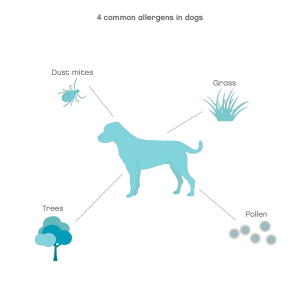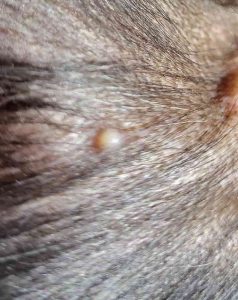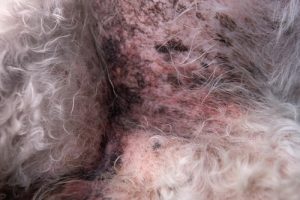Skin allergies in dogs are extremely common. In this article, we discuss atopic dermatitis, caused by allergies to the environment. It affects up to 1 in 10 dogs in the UK. Skin allergies can occur at any age, but symptoms often start around 1-3 years old.
Skin allergies are due to a reaction to allergens in the environment. It is also known as atopy, atopic dermatitis, environmental allergy, a grass or skin allergy, or allergic skin disease. Dogs diagnosed with this condition will need life-long treatment but can have a good quality of life with the correct treatment plan.
Overview
What are skin allergies in dogs?
Atopic dermatitis is a skin disease due to a reaction to allergens in the environment.
- In dogs with atopic dermatitis, when allergens come in contact with the skin, the immune system has an exaggerated response
- This inflammatory response is the reason for the main sign of atopy, which is itching
- Itching and scratching often lead to a skin infection caused by bacteria or yeast
- There is a genetic component of atopic dermatitis and affected dogs have weaker skin barriers
- Atopic dermatitis can get worse during certain seasons of the year
- Common allergens include pollen, dust mites, grass, and trees.
- Other common allergic diseases include food allergies and flea bite allergies
- Environmental and food allergies both have similar symptoms
- Dogs can have both food and environmental allergies

The signs of atopic dermatitis can worsen without the correct treatment plan. Our Joii team is available 24 hours a day for advice. Call us now if your dog has allergies.
Symptoms
Symptoms of skin allergies in dogs
Itching is the main symptom of skin allergies. This can manifest as licking, scratching, or biting excessively.
Lesions can occur anywhere on the body but are most common on the paws, tummy, inner legs, ears, and face.
- Red, inflamed skin
- Hair loss
- Skin lesions, such as white-head spots, red spots, a rash, crusts, and scabs
- Thickened and darkened (hyperpigmentation) areas of skin
- Saliva staining causes brown-red areas due to excessive licking
- Hot spots

- Pustule (white spot)

- Hyperpigmentation and thickened skin
Allergies can affect other areas of the body causing:
Risk
Are some dogs more at risk of skin allergies than others?
Any dog, regardless of breed, sex, or age, can develop this condition. The risk factors are:
- Genetics: meaning it can pass from parents to puppies.
- Breed predisposition: Labrador and Golden Retrievers, West Highland White Terriers, Bulldogs, Boxers, Bichon Frise, Shar Pei, German Shepherds, and Pugs.
- Age: The symptoms usually start around 1-3 years old.
Is my family at risk of catching skin allergies?
Atopic dermatitis in dogs is not contagious to humans or other pets in the household.
Diagnosis
How are skin allergies diagnosed in dogs
Environmental allergies in dogs can be complex to diagnose. Because the symptoms of atopic dermatitis can be similar to those of many other conditions, we need to rule out other causes in a systematic way.
A full physical examination is important as the first step to determine what parts of the body are affected and how severely they are affected.
Skin testing
- Skin scrapes to check for mites such as Sarcoptes and Demodex (mange)
- Flea paper test to check for flea dirt
- Skin swabs to look at any areas of skin infection and determine what type of bacteria or yeast are present
- Skin biopsy and hair plucks may also be done.
Diet trial
- After parasites are ruled out, the next step is to check for food allergies.
- A hydrolysed protein diet is used for at least 6–8 weeks to assess the response. Hydrolysed diets are made from proteins that are broken down into small pieces to avoid any immune reaction.
Allergy tests
- Blood or skin tests that check for specific allergens in your dog’s body. Skin tests will require sedation.
- An exam with a scope to look down the ear canals
- Swabs of the ears to check what type of infection is present
Blood and urine tests
- To check for any other conditions such as kidney disease or diabetes
Vet treatment
What’s the treatment for skin allergies in dogs
Treatment for skin allergies usually involves a multi-modal approach to reduce or completely eliminate the signs. This involves working with your vet to try different options to find what works best for your dog.
Treatment of secondary skin infections
- Antibiotics or antifungals may be needed
- Depending on how severe the infection is, treatment may be topical (shampoo, wipes, or creams), oral or by injection
- Parasite treatment to protect against fleas and other parasites
Anti-itch medication
- Anti-histamines work well for some dogs with mild itching
- Steroid sprays may be used for mild cases
- Steroid tablets are very effective and inexpensive, but can lead to side effects such as obesity and poor wound healing.
- Apoquel: comes in tablet form and has fewer side effects than steroids but is more expensive.
- Cytopoint: comes in injection form and is usually given every 4 weeks. It also has much fewer side effects than other treatments. This is one of the most expensive treatment options.
Allergen-specific immunotherapy
- A medication made specifically for each patient based on the results of skin or blood tests for allergies.
- Helps to desensitise the body to different allergens. It works to reduce the severity of the symptoms of allergies and is usually given by injection every 2-4 weeks.
- It can be expensive in the beginning to set-up but less so with ongoing treatment. Side effects are rare with this treatment.
Ear infections
- Ear cleaners to clean the canal and break up the wax
- Medicated ear drops containing antibiotic, anti-inflammatory, and antifungal components
Home treatment
How to look after a dog with skin allergies at home
Allergies can be tricky to treat, and it’s recommended to take a multi-modal approach. This means using different products and methods to improve the signs. Depending on the severity of the symptoms, some dogs with mild itching may only need prescription medication during a seasonal flare-up.
At home recommendations
- Keep your dog up to date with parasite preventatives, especially fleas
- Feed a good quality, complete diet. Hill’s food, Derm Complete, is useful for a range of conditions that can cause your dog to be itchy. It is proven to help with both food and environmental allergies.
- If your dog is diagnosed with specific allergies, try to avoid contact with them. For example, avoid walking when the pollen count is high, avoid long grass, hoover and dust regularly, and feed certain foods.
- Skin supplements containing omega oils can improve the skin barrier
- Use a buster collar or medical suit to prevent self trauma
- Calming or medicated shampoos, mousses, wipes, and gels are useful for certain conditions, including mild skin infections. These are often antibacterial and also soothe the skin.
- Regular ear cleaning may be advised if your dog is prone to infections. Some ear cleaners can also help with mild irritations or infections.
It’s always best to seek the advice of a vet if your dog shows signs of being itchy. Home remedies may be helpful for certain conditions, and your vet can guide you on the best ones to look for.
Tips on how to live with a dog with skin allergies
Atopic dermatitis is a life-long condition. Costs of treatment may be higher with certain medications or at the beginning of treatment when trying to work out which medication works best for your dog. It’s best to work with your vet from the beginning, before symptoms get worse and treatment becomes difficult.
Prevention
Tips on how to prevent skin allergies in dogs
Unfortunately, skin allergies are not preventable, but following these steps can help reduce the severity of the symptoms:
- Keep all of your household pets up to date with parasite preventative, especially for fleas
- Regularly clean your dog’s bedding, collar, and bowls
- Dust and vacuum the house often, and avoid sprays or perfumes in the house
- Dust mite spray for the house is useful for dogs with these allergies
- Feed your dog high-quality, complete food for their age and lifestyle. Some brands also have a special skin care range with high omega oil levels.
- Some dogs benefit from regular bathing, shampooing, and ear cleaning. Follow professional advice for this, as bathing too often can also cause problems.
- Brush your dog and check for any abnormal areas of skin at least once a week
- Get your dog checked over with a vet as soon as possible if they become itchy to help prevent self-trauma to the skin
When to worry
When you should be worried about skin allergies in dogs
Seek help from a vet if:
- Your dog is constantly itching
- Your dog has thickened, swollen ears or a head tilt
- Your dog needs prescription medication
Call us and speak to one of our Joii vets if:
- You want to find out how to do a food trial
- You want to know what skin supplements are best for your itchy dog
- You have any questions about parasite control in dogs








